

At just 22 years old, Holger Rune carries the fire of a self-made warrior in tennis, a player who forged his own path where almost no blueprint existed. Denmark, a land not known for churning out tennis champions, has given the sport only a handful of elite figures, with Caroline Wozniacki being the most prominent anomaly. And yet here stands Rune, already ranked No. 11 in the world, walking into the cauldron of the US Open as one of the faces tipped to lift the crown.
Watch What’s Trending Now!
His story begins where no federation held his hand and no national system cleared his way. “We had to do it by ourselves. We didn’t have a federation that took cause for you or anything like that,” Rune said two years ago, his voice carrying the defiance of a man who knows the depth of his own scars. Those words, spoken years ago, remain the song of his journey, an anthem of independence and fight.
In an exclusive conversation with EssentiallySports, Rune sat down with Nate Francis to peel back layers on pressure, Novak Djokovic, and his own evolving game, pressure. The Dane spoke without hesitation, a player fully aware of what it takes to climb, fall, and rise again in the brutal theater of tennis.
ADVERTISEMENT
“Embrace it, you know?” Rune said with a smile when asked about handling pressure. “Of course. It comes with pressure, but it’s a part of it.” His words revealed not fear but appetite; pressure, for him, is not a burden but the ticket to eternity in the sport’s pantheon.
Rune explained that pressure has never been an outside force; it has always been his own creation. “I feel like, you know, since I was super young, I always put pressure on myself, and because that’s a that’s a scary time in a way, and I want to win. I want to do crazy things and stuff, so you know, I try to cope with it as good as possible. But yeah, sometimes you feel it,” he added.
That inner fire has carried him through the deepest battles, especially against Novak Djokovic. Rune’s head-to-head record against the Serbian sits at 2-4, but numbers hardly tell the full tale. Paris 2022, Rome 2023, these clashes became stepping stones in Rune’s education under fire. Each encounter etched lessons in his bones.
ADVERTISEMENT
“Yeah, yeah, no, you learn a lot. I mean, especially before the matches you have, so many, I call it like birds in my stomach, you know, flying around, you’re so excited,” he admitted, reflecting on facing Djokovic. “And, and then, once you get on the court, it’s just nice because you know, you have to fight.” Rune’s voice softened, almost reverent, speaking of Novak’s greatness and the inevitability of war against a legend.
For context, Djokovic, even at 38, opened his US Open campaign by dismantling 19-year-old Learner Tien in straight sets. Rune observed this ageless brilliance and distilled it into his own creed. “Whatever you have inside you, you know, it’s, uh, if you don’t do that, you’re gonna lose for sure. And even if you do that. You might lose as well, so. But that’s the only chance to win and, and I have this, I think great belief in myself that I can beat anyone on any day on any surface, so that helps me a lot. So, to believe the impossible, which there’s nothing is possible.”
ADVERTISEMENT

Imago
2024-07-08 The Championships Wimbledon 2024 Day 8 LONDON, UNITED KINGDOM – JULY 8: Novak Djokovic of Serbia and Holger Rune of Denmark on Day 8 of The Championships Wimbledon 2024 at All England Lawn Tennis and Croquet Club on July 8, 2024 in London, United Kingdom. Photo by Marleen Fouchier/BSR Agency London United Kingdom Content not available for redistribution in The Netherlands directly or indirectly through any third parties. Copyright: xBSRxAgencyx
That belief took shape in his breakout 2022 season, where he stormed through titles in Paris, Stockholm, Munich, and the Bavarian Championships. His aggressive, fearless style became his signature. He thrives when he strikes boldly, as he showed earlier this year at the Barcelona Open. There, in Spain, against Carlos Alcaraz, Rune silenced a partisan crowd and beat the home hero in a cauldron that later witnessed Alcaraz’s own triumph at Roland Garros.
“You know, it’s fine. I mean, my favorite is to play aggressively, but I also like, sometimes just to grind, you know, like, just to to be dirty, you know, just slice, and I can run high Top Spin and stuff. I think you need all of these parts in the game, and then you need to know when to use them,” Rune explained. His words spoke not just of versatility but of survival, the willingness to use every weapon, pure or scrappy, in pursuit of victory.
ADVERTISEMENT
Francis pressed him on his deft touch at the net, those cat-and-mouse drop shots that disarm opponents mid-battle. Rune leaned into the question. “Not for sure. I think it is something you need to practice, you know?” he said. “But also, you know, if you have this natural verity in your game, you’re also going to do it when you play normal sets. You’re gonna, you know, mix it in the drop shot, there is, you know, this game will appear.”
Rune even gave a rare glimpse of his practice court chemistry, speaking about a recent session with Lorenzo Musetti. “Like, today, I train with Musetti. We had a lot of fun rallies like this. So, but, uh, yeah, yeah, I think honestly, it’s something you learn from a young age since you like coming to the net. If you really force yourself to train it, I think that’s so important because you know so many coaches and players, they forget this part of the game.”
And yet, no player is invincible. Rune acknowledged what the sport often proves, that every great has blind spots. Take the example of Rafael Nadal, the clay court emperor with 14 Roland Garros titles but only two Wimbledons. Or let’s say Naomi Osaka, who conquered four majors on hard courts but never cracked Paris or Wimbledon. Even the icons bleed somewhere!
ADVERTISEMENT
Rune’s candor in admitting this echoed his maturity. Weakness is not something he shies away from; it is the balance to his aggression, the counterpoint to his ambition. His willingness to recognize flaws while chasing greatness is what makes his journey uniquely magnetic.
Holger Rune opens up about his weakness
Holger Rune has never had the smoothest of rides at Flushing Meadows. For years, the US Open felt like a cursed stage for the Dane, a place where early exits became his unfortunate rhythm. Three first-round defeats in four appearances left him searching for answers, including two consecutive heartbreaks in New York.
ADVERTISEMENT
But on Monday, something shifted. Under the bright skies of the Grandstand, the No. 11 seed carved out a victory he desperately needed, taking down Dutchman Botic van de Zandschulp 6-3, 7-6(4), 7-6(2). For the first time since 2022, Rune walked away from the US Open grounds with a spring in his step.
Yet, the scoreboard only tells half the tale. Rune’s 2025 campaign has been a mixture of brilliance and frustration: a 28-16 win-loss record with just one title to his name. The fire is there, but the results haven’t always matched.
Top Stories
Line Call Drama Interrupts Venus Williams vs Madison Keys Match at Charlotte Invitational
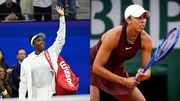
Frances Tiafoe Makes Feelings Clear About Taylor Fritz After Brutal Clash: “Can’t Stand Him”
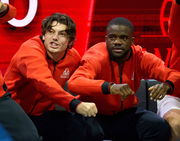
Stefanos Tsitsipas’ Mother Gets Honest About Her Son’s Surprising Statements: “Stood There With My Mouth Open”

Serena Williams Talks About Dad ‘King’ Richard, Her Multimillion Dollar Empire, & More, Days After Comeback Buzz
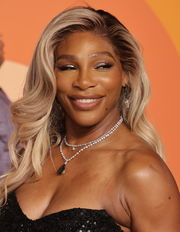
2025 ATP Awards Nominations: All You Need to Know
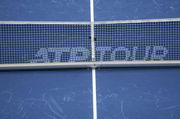
And in the same exclusive sit-down with Francis before his 1st round match, Rune was brutally candid about what he sees as his greatest challenge. “Me and my team are working is very good, very intense, very detailed, and small things. So, you know, we’re trying to put Break by, break into each other, and trying to, you know, this is the most important tournament that’s left in this year. So, trying to give the last push and and see if I can get it any.”
ADVERTISEMENT
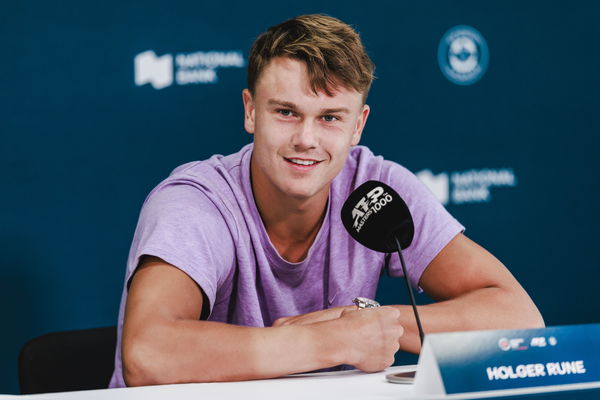
Imago
July 29, 2025, Toronto, Ontario, Canada: HOLGER RUNE of Denmark is seen during a press conference, PK, Pressekonferenz at the 2025 National Bank Open at Sobeys Stadium in Toronto, Ontario. Toronto Canada – ZUMAt160 20250729_zip_t160_001 Copyright: xMathewxTsangx
When pressed on what part of his game has demanded the most attention, Rune did not hesitate. “My footwork, actually, especially the last couple of weeks to be in a better position to get more quality and less mistake on the. Because that’s, you know, as I have an amazing food rate, but sometimes I’m too lazy. So, you know, I need to step up my footwork.” It was the kind of raw honesty rarely heard from a player still climbing the heights of his career.
That self-awareness has been his compass in 2025. Rune reached the Indian Wells final and fought deep into the draws at both the Australian and French Open, making the fourth round each time. The progress is undeniable, yet the weight of Slam expectation lingers. For all his talent, the Danish star has yet to break through beyond a quarterfinal at a major.
ADVERTISEMENT
And just days after the first round win, Holger Rune’s 2025 season at the Grand Slams slipped away in heartbreak. Under the lights of Stadium 17, the Dane’s journey ended with another bitter note. What was supposed to be a triumphant fight turned into a saga of grit, endurance, and, ultimately, disappointment.
The battle with 35-year-old Jan-Lennard Struff was not for the faint of heart. For 3 hours and 25 minutes, both warriors traded blows in a match as balanced as tennis can ever offer, each man seizing exactly 159 points. Rune’s fire met Struff’s steel, first serves blazing at a relentless pace.
Struff edged slightly higher, landing 82% of first-serve points compared to Rune’s 80%. And in the end, it was the towering German, hammering down 28 aces, who stole the moment with a 7-6(5), 2-6, 6-3, 4-6, 7-5 masterpiece.
Rune, exhausted yet unbowed, gave words that carried both respect and despair: “It was incredible how my opponent played, I tip my hat to him, he took tremendous risks, was better at crucial moments, and I was unlucky.” But beneath the courtesy, frustration simmered as he confronted the harsh truth of the modern era. “It’s very hard to win a Grand Slam right now. Probably, there will be another final between Sinner and Alcaraz. Besides them, only Djokovic and Zverev could emerge as champions of this event.”
And so, the curtain falls on Rune’s Grand Slam year, another chapter of near-misses and aching dreams. Yet, tennis is cruel and beautiful that way. Tomorrow always whispers new hope.
Can Rune break the curse in Melbourne, rise above the giants, and carve his destiny at the Australian Open next year? Only time will sing that answer.
ADVERTISEMENT
ADVERTISEMENT
ADVERTISEMENT

